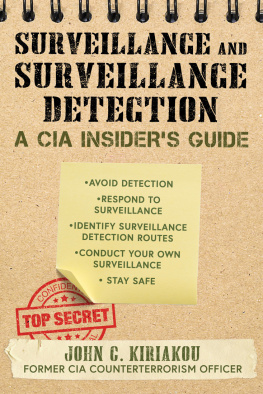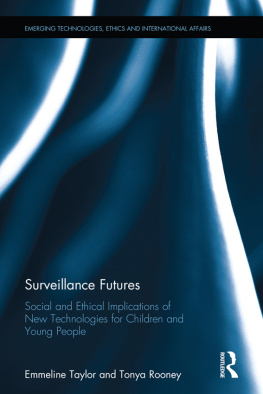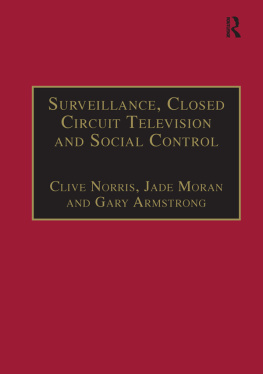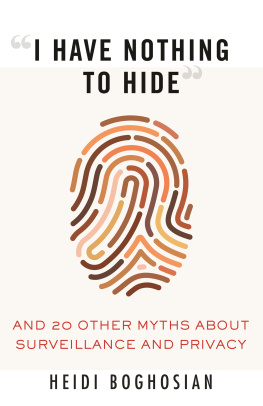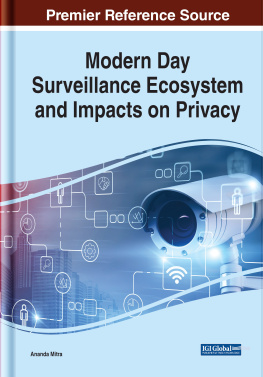The Maximum Surveillance Society
First published 1999 by Berg Publishers
Published 2020 by Routledge
2 Park Square, Milton Park, Abingdon, Oxon OX14 4RN
605 Third Avenue, New York, NY 10017
Routledge is an imprint of the Taylor & Francis Group, an informa business
Clive Norris and Gary Armstrong 1999
All rights reserved. No part of this book may be reprinted or reproduced or utilised in any form or by any electronic, mechanical, or other means, now known or hereafter invented, including photocopying and recording, or in any information storage or retrieval system, without permission in writing from the publishers.
Notice:
Product or corporate names may be trademarks or registered trademarks, and are used only for identification and explanation without intent to infringe.
Library of Congress Cataloging in Publication Data
A catalogue record for this book is available from the Library of Congress.
British Library Cataloging in Publication Data
A catalogue record for this book is available from the British Library.
Typeset by JS Typesetting, Wellingborough, Northants.
ISBN 13: 978-1-8597-3221-2 (hbk)
ISBN 13: 978-1-8597-3226-7 (pbk)
There are many people and institutions to whom we owe thanks in bringing this book to fruition. Gratitude is due to those who granted us access to their CCTV control rooms and allowed us to observe the reality of CCTV surveillance. We are also extremely grateful to the dozens of CCTV operatives who tolerated our presence over long shifts whilst allowing us to watch them at work. Thanks are also due to the system managers and industry representatives throughout the country who gave up their time to be interviewed.
The primary funding for the project came from the Economic and Social Research Council under its Crime and Social Order Programme (Grant no. L210252023). This was given a further boost by the University of Hulls Research Support Fund which financed a project entitled Developments in Algorithmic Surveillance. We are grateful to both institutions.
We are grateful to Macmillan who allowed us to draw freely on an earlier article of ours entitled The Rise of the Mass Surveillance Society which was published in Crime Unlimited: Questions for the 21st Century edited by Pat Carlen and Rod Morgan (Macmillan, Basingstoke and London: 1999). We are also grateful to Petards International Limited, 10 Windmill Business Village, Brooklands Close, Sunbury on Thames, Middlesex TW16 7DY for permission to reproduce their skinhead advertisement which appears on our front cover.
Our colleagues at the Centre for Criminology and Criminal Justice at the University of Hull, especially Keith Bottomley, Clive Coleman and Norman Davidson deserve thanks for providing an interesting and supportive environment in which research can be conducted. Christine Kinnan and Diana Grey provided the most exceptional administrative support which as well as being supremely efficient, was unfailingly helpful and good-humoured, we thank them both. Thanks are also due to Karen Kinnaird who so efficiently transformed the field notes from a scrawl to immaculate typescript.
Numerous friends and colleagues helped throughout by offering encouragement and providing a sounding board for our ideas. In particular we would like to thank Jon Bannister, Marjorie Bulos, Madeline Colvin, Simon Davis, Jason Ditton, Ian Drury, Nigel Fielding, Nicholas Fyfe, Richard Giulianotti, Stephen Graham, Jenny Hockey, Mike McCahill, Mike Maguire, Richard Nicholls, Peter Noorlander, Alan Reeve, Julie Seymour, David Skinns, Peter Squires, Ian Taylor, Nick Tilley and Malcolm Young. Nigel Norris deserves a special thank you for providing fraternal support and agreeing to read the entire manuscript in an effort to weed out its more obvious failings. The responsibility for those that remain is ours but they are far fewer in number!
A special thank you is also reserved for Jade Moran, who in her role as research assistant expertly compiled, collated, summarised and indexed the wealth of articles, newspaper clippings and trade reports on which much of this book is based, but also so professionally conducted a series of interviews with representatives from the CCTV industry. We are forever in her debt.
At Berg, our publishers, we thank our commissioning editor Kathryn Earl for her faith and patience, Bobby Gainher who diligently copy-edited the manuscript and Sara Everett for so efficiently transforming our typescript into this book.
And finally to our partners, Laurie Nicholls and Hani Armstrong who supported this project in countless ways but, more importantly, reminded us both that there is more to life than research.
Part I
Images of Social Control
1
Introduction: Visions of Surveillance
This is a book about watching people. It examines the rise of camera-based surveillance that is embodied in the proliferation of closed circuit television cameras (CCTV). In Britain it is now virtually impossible to move through public (and increasingly private) space without being photographed and recorded. Whatever our role as we pass through the urban landscape we are subject to the presence of the cameras. As consumers we are monitored by the routine use of cameras in retail outlets; whether in the supermarket, department store or comer shop. When we leave the store our image, in all probability, will be captured by high street, town centre and shopping mall camera systems. On our journey home, traffic cameras will monitor our compliance with speed and red light restrictions and, if we travel by rail, cameras at stations and along platforms will ensure a record of our presence. In other roles, whether it be as workers on the factory floor or at the office, as students, from kindergarten to university, as hospital patients, football fans or even customers at a local restaurant, cameras are probably watching over us. Put simply, in urban Britain, at the cusp of the millennium, in almost every area to which the public have access we are under surveillance from CCTV.
The book has three aims: to provided a critical account of the recent exponential growth of camera-based surveillance in Britain; to document the actual practice of CCTV surveillance as it is carried out in the high streets and town centres of British cities; and to anticipate the future direction of this technology of social control. Before outlining the organisation of this book in more detail this introduction will briefly explore how surveillance has been conceptualised in both popular and academic discourse.
Throughout the twentieth century the idea of surveillance has become inscribed in mass consciousness, not primarily through the learned tomes of academics, but through its artistic treatment in popular culture. In the English-speaking world, at least, the most enduring, and often haunting images are to be found in films such as Hitchcocks Rear Window, Francis Ford Cappolas The Conversation (1974) or Michael Powells Peeping Tom (1960). Popular song has also taken up the theme of surveillance (see Marx 1995) the most memorable being the Polices Every Breath You Take (1983). In literature, George Orwells Nineteen Eighty-Four (1949) and Huxleys Brave New World (1932) still feature as essential reading on many school curricula.
What unites these classics of popular culture is their tragic and dystopian portrayal of the personal and political impact of surveillance. In



